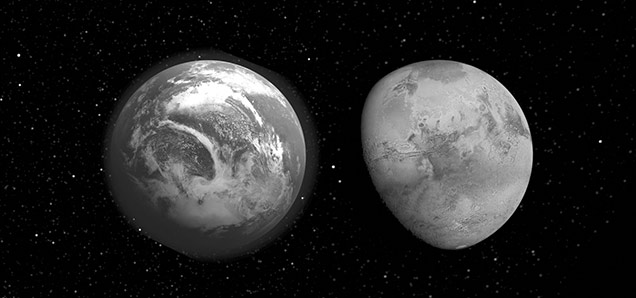One small step for man, one giant leap on Mars
 CREDIT: NASA'S GODDARD SPACE FLIGHT CENTER
CREDIT: NASA'S GODDARD SPACE FLIGHT CENTERAn artist concept depicts the early Martian environment - believed to contain liquid water and a thicker atmosphere (left) - versus the cold, dry environment seen at Mars today (right).
Population on the Red Planet has steadily grown since the 20th century – but not with humans. Following NASA, Russia and the European Space Agency (ESA) – India has sent a probe with its own triumph for the records.
The Mangalyaan Mars Orbiting Mission sent back its first images of the planet: a pockmarked surface mottled with dark grey over a range of red and oranges, then a view of its thin red atmosphere, with Mars silhouetted by the blackness of space – victory for India.
Launched from the Sriharakota Range in October, the Mangalyaan is filled with scientific instruments meant to analyze the Martian atmosphere and geology for possible signs of life.
Using local manufacturing and engineering routes, the Indian Space and Research Organization (ISRO) attributed the $70 million price tag to dedicated round-the-clock staff, combined with using a single probe for both testing and launch.
India sent a probe to Mars for less than than $100 million, the cost of making Gravity, a point India Prime Minister Narendra Modi wasn’t shy about.
“We have gone beyond the boundaries of human enterprise and innovation,” Modi said during a live press broadcast at the ISRO command centre. A powerful statement as more than half the 55 Mars missions have failed: Exploding before leaving earth, zooming past Mars, vehicle separation issues – all have destroyed countless hours of scientists work and sent them back to the drawing board.
Mangalyaan directly drew from India’s successful 2008 Chandrayaan launch to the moon, which found water deposits in soil across the lunar surface, and also confirmed that the moon was originally a fiery molten sphere.
Students expressed many interests when learning of Mangalyaan’s intended research.
“I want them to find water… I want to see if humans are able to survive on Mars,” said Shaenel Morris, a first-year Recreational and Leisure student. “Because where there’s water there’s oxygen.”
“They keep talking about finding life on Mars, which would be unreal,” said General Business student Tori Taylor. “I’m not sure they’ll find anything...but it would be neat if they found some little creature.”
Students were most intrigued with the possibility of finding life.
To help with students’ wishes, planetary scientists received a second gift. On September 22, NASA’s Mars Atmosphere and Volatile EvolutioN Mission (MAVEN) probe achieved Martian orbit, quickly sending back ultraviolet images.
Its primary mission will be studying Mars’ atmosphere, determining how and why so much is missing.
It’s an exciting time for space research: Boeing and SpaceX being awarded human spaceflight contracts by NASA; the ESA Rosetta probe arrival to comet 67P, and launch testing on the Orion spacecraft; the NASA launch vehicle sending humans to Mars in 2030 – scheduled for this December.
This is the new Space Age.













